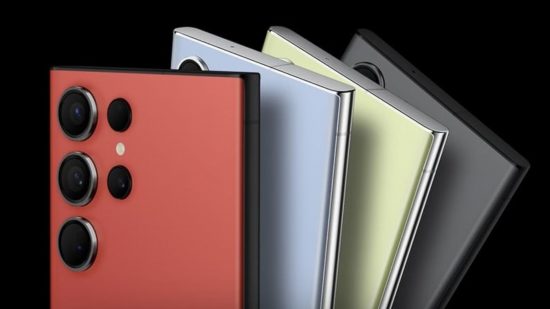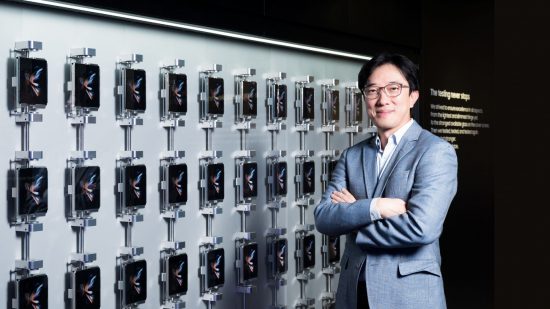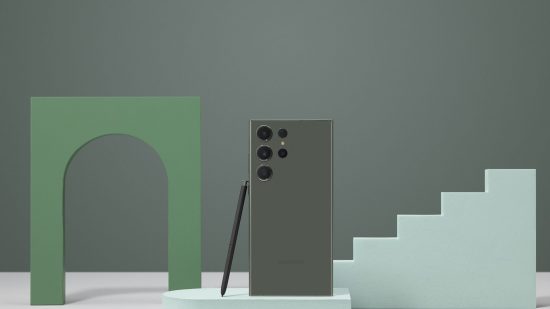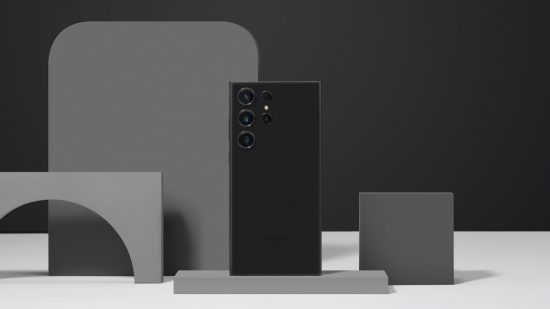“When we launched the S23… our main focus was camera and performance. Today, we just want to focus on performance.” This is one of the first things Won-Joon Choi would say to me. Sounds like Samsung wants to remind mobile game fans of something.
I’m sat inside the Hotel Porta Fira Barcelona drinking water out of a wine glass and waiting to interview Won-Joon Choi, Executive Vice President, Head of Mobile R&D at Samsung. I just got off a flight and definitely look scruffier than I should. But then again, I’m not here to talk business, I’m here to talk gaming, so it’s fine right?
Outside is the Fira Grand Via exhibition centre, right next to a massive roundabout with a cube of billboards in the middle of it. All four are advertising the Samsung Galaxy S23 series, one side showing off a racing game and Samsung’s AirPods competitor, the other the sleek back of the two new phones. It’s cold but sunny, and I’m sweating a little bit.
About 138 hours later I’d be walking through Barcelona at night, and look up to see another Samsung Galaxy S23 Ultra, this time on the Catedral de la Santa Creu i Santa Eulàlia. I posted a photo of it on Instagram and dubbed it the Samsung Galaxy S23 Ultra Catedral de la Santa Creu i Santa Eulàlia. I was making a joke.
All this is to say, MWC 2023 was loud with Samsung. While Oppo may have turned up the volume in terms of London Underground advertising, Samsung is making a different sort of statement. ‘Biggest mobile trade show? We own it’ – that sorta thing.
I go up some stairs that I was earlier refused passage by a security guard, assumedly because of my sweaty and scruffy demeanour. I go into a lift to the 24th floor. I ask how many floors there are. There are 24.
I walk into the meeting room – La Mordella. There are five people inside. One is Won-Joon Choi. Another is some sort of PR assistant, who would later whisper some stuff in his ear after I ask a question. Another is an interpreter – Won-Joon speaks excellent English, though some answers were in Korean. Another is working the slides on the projector. The final person doesn’t look up from the laptop they’re typing on.
So, uhh, what was I here to do again? Oh, yeah, ask some questions. You see, Samsung wants to remind everyone that it makes phones with a lot of power packed inside. It wants to court the game-likers. So, it’s invited the number one mobile gaming site in the world to have a chat about it.

The new Samsung Galaxy S23 Ultra has a special Qualcomm Snapdragon 8 Gen 2 inside. Instead of its main Kryo CPU core clocking in at 3.2 GHz, as it does in the standard chip, you get 3.36 GHz. Plus, the Adreno GPU clocks in at 719 MHz instead of 680 MHz. Qualcomm and Samsung even say it can do ray tracing…
This special partnership between the two is notable. Won-Joon used to work at Qualcomm. Now, over at Samsung, the company can say it has the fastest chip in an Android phone. It even beats the iPhone 14 Pro on some benchmarks. Did Won-Joon just call his buddies back at Qualcomm and ask for some extra special sauce? Well, no.
“We work with all of the major chipset partners from the ground up. So, that was the case for Snapdragon 8 Gen 2 as well. We’ve been involved from the very beginning of the planning, letting them know about our requirements for the performance as well as architecture,” Won-Joon says. Not exactly a thrilling tale, so I dig a little.
So, is Samsung moving anway from in-house chips for its flagships, or is this just a one off? Apple silicon’s success across its different devices has become especially apparent in recent years. Then again, the chip in the Galaxy S23 Ultra does compete with Apple’s most recent top-end mobile chip, the A16 Bionic.
Short answer: no. “Of course, these major chipset companies have their strengths,” Won-Joon (above) says, “so we will continue to strengthen our collaboration with these partners. And then, on one hand, there are solutions that can be differentiated for Galaxy, so we will develop those internally and add them on through our collaboration.”
So, this is where Samsung is at when it comes to powering its mobiles. Qualcomm is giving the company what it needs in a clearly fruitful partnership. And it has created a chip that can do ray-tracing, a feature Apple had to scrap on its most recent pro phone at the last minute after discovering key mistakes and being “too ambitious with adding new features” (a mistake “unprecedented in the group’s history”, all according to The Information).
So, is the ray-tracing claim just a good headline to have, after Apple failed to push through its next-generation pro silicon? Or is it a reality we can expect to see? Luckily, both Samsung and Qualcomm are pretty reasonable about the realities of ray tracing on mobile.
“We’re not quoting any types of numbers. But I think some of it’s about working with the game developers to understand, like, typically, not every scene has ray tracing, right? So what are those scenes that we really want to optimise that are truly going to be impactful to the user?” Mike Roberts, VP, Head of Global Product, Partner, and Technology Marketing at Qualcomm – crikey, what a mouthful – said in a roundtable I attended a few days after meeting Won-Joon.
“Hardware-based ray tracing has been something we’ve been chasing for many, many years, in fact, that is here today, that’s going to continue to improve,” he said. “When you think of consoles, you know… of what Xbox and PlayStation and Nintendo are doing in their next-generation consoles, I think there isn’t going to be this huge gap between them.”
This lofty aim is admirable, sure. But the reality is, just because hardware-based ray tracing is theoretically possible, doesn’t mean us lay folk get to use it. In fact, as far as I can tell, there’s not a single game that uses it that’s currently fully released. I do like Samsung’s ambition combined with realism, however, and a clear understanding that it’s the developers who need to implement it, after all.
“We’ve been working with chipset partners for many years to look at and provide this ray-tracing feature in-device,” Won-Joon told me. “As a result, we were able to introduce the chipset capable of hardware-accelerated ray tracing in our current generation of S23.
“It’s not just the hardware capability that we require, we need the game developers to develop games where they use ray tracing. In this respect, we don’t plan to sit idle and just look at the situation passively. We want to be actively involved and that is why we already began cooperation with a couple of game developers.
“We are providing them with optimization assistance in developing their games. So once this work is matured we’ll be able to actually see the games with ray tracing on the market.” Okay, so those partners, who are they? Is it a secret? Yep, not allowed to know. Sure we’ll find out soon enough.
Anyway, hardware this hardware that, we get it. This new chip is fast. But the main focus of the short presentation I received beforehand was “performance”, and performance comes from both hardware and software. And Samsung is also very keen to talk about the latter.
The company developed an adaptive AI algorithm to bring efficiency gains depending on what game you’re playing. I’m not very clever, so I couldn’t begin to fully understand how it all works, but I am intrigued if there could be a case where it doesn’t work correctly. Could a game trip up the algorithm?
“The adaptive algorithm didn’t happen overnight.” Glad we cleared that up. “It’s the result of our longtime development and collaboration… of course, you cannot say that it’s always 100% optimised… there could be some specific titles with software bugs or glitches.” Of course, if this does occur, Samsung says it will resolve the issue.
While this certainly isn’t the first time Samsung has focused on gaming performance, it feels like a concerted effort is going on to let people know that these lovely, shiny phones with big, excellent cameras can also pack a gaming punch. I’m not expecting the S24 to have RGB and a Doritos partnership, but how does Samsung plan to keep pushing the phone to please this market?
“As an engineer, there is always something I wish I could have incorporated in the development and thinking about my past history of launching many different products, I can say this confidently, I can say that S23 is very close to what we were looking for and what we were hoping for when we started planning. But, of course, it can never be 100% perfect.”
So, cards close the chest again. When I press further, Won-Joon says that Samsung listens to consumers and what they want. All I’d say is don’t expect passthrough charging or some other game-focused feature. These are still all-rounders, still flagships at the end of the day.
This flagship’s stats kind of makes Samsung the de facto leader against Apple, with the company pulling ahead of its primary Android competitors thanks to this Qualcomm partnership. While talking about other Android phones is nice and all, we all know that Samsung makes good phones (just google “best Android phone 2023”). So, Apple has to be the focus of comparison.
And, with Apple dominating Gen Z, according to a new report from the Financial Times – 34 per cent of all iPhone owners in the US are Gen Z, but only 10 per cent of Samsung users – how does the company plan to compete? I’m Gen Z. I recorded this interview on an iPhone. Is Samsung worried about convincing the younger generation?
Well, that’s hard to say. “It is the philosophy of Galaxy to cover the needs and wants of all age groups, not just Gen Z, and all of their needs and all of their values,” Won-Joon says. “Just like any other age group, we are always listening to the feedback of Gen Z so that we can deliver the values and the needs that they have so that they can love us even more.” So, Samsung wants to cater to everybody. How does that saying go again? Jack of all trades…?
Well, maybe that’s a bit mean. The Samsung S23 Ultra is a master at most of what it does. It’s probably the best smartphone currently available. But it’s so hard to get under the surface here, no tactics or ideas for the future of Galaxy, just a reminder that the new thing the company made sure is powerful. Even if games leveraging that power are few and far between, at least you know the power is in there. Hidden away. Ready for the big day.






